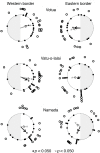Size matters: Predator outbreaks threaten foundation species in small Marine Protected Areas
- PMID: 28166257
- PMCID: PMC5293237
- DOI: 10.1371/journal.pone.0171569
Size matters: Predator outbreaks threaten foundation species in small Marine Protected Areas
Abstract
The unanticipated impacts of consumers in fragmented habitats are frequently a challenge for ecosystem management. On Indo-Pacific coral reefs, crown-of-thorns sea stars (Acanthaster spp.) are coral predators whose outbreaks cause precipitous coral decline. Across large spatial scales, Acanthaster densities are lower in large no-take Marine Protected Areas (MPAs) and reefs subject to limited human exploitation. However, using a combination of observational and manipulative experiments, we found that Acanthaster densities within a network of small, no-take MPAs on reef flats in Fiji were ~2-3.4 times greater inside MPAs than in adjacent fished areas and ~2-2.5 times greater than the upper threshold density indicative of an outbreak. This appeared to result from selective Acanthaster migration to the coral-rich MPAs from fished areas that are coral-poor and dominated by macroalgae. Small MPAs can dramatically increase the cover of foundation species like corals, but may selectively attract coral predators like Acanthaster due to greater food densities within MPAs or because the MPAs are too small to support Acanthaster enemies. As coral cover increases, their chemical and visual cues may concentrate Acanthaster to outbreak densities that cause coral demise, compromising the value of small MPAs. An understanding of predator dynamics as a function of habitat type, size, and fragmentation needs to be incorporated into MPA design and management.
Conflict of interest statement
The authors have declared that no competing interests exist.
Figures




Similar articles
-
Overlooked coral predators suppress foundation species as reefs degrade.Ecol Appl. 2018 Oct;28(7):1673-1682. doi: 10.1002/eap.1765. Epub 2018 Jul 26. Ecol Appl. 2018. PMID: 30048025 Free PMC article.
-
Small Marine Protected Areas in Fiji Provide Refuge for Reef Fish Assemblages, Feeding Groups, and Corals.PLoS One. 2017 Jan 25;12(1):e0170638. doi: 10.1371/journal.pone.0170638. eCollection 2017. PLoS One. 2017. PMID: 28122006 Free PMC article.
-
Predator crown-of-thorns starfish (Acanthaster planci) outbreak, mass mortality of corals, and cascading effects on reef fish and benthic communities.PLoS One. 2012;7(10):e47363. doi: 10.1371/journal.pone.0047363. Epub 2012 Oct 8. PLoS One. 2012. PMID: 23056635 Free PMC article.
-
Crown-of-thorns seastar (Acanthaster spp.) feeding ecology across species and regions.Sci Total Environ. 2024 Jun 20;930:172691. doi: 10.1016/j.scitotenv.2024.172691. Epub 2024 Apr 23. Sci Total Environ. 2024. PMID: 38663591 Review.
-
Dead foundation species create coral rubble habitat that benefits a resilient pest species.Mar Environ Res. 2024 Nov;202:106740. doi: 10.1016/j.marenvres.2024.106740. Epub 2024 Sep 5. Mar Environ Res. 2024. PMID: 39255629 Review.
Cited by
-
Typical Marine Ecological Disasters in China Attributed to Marine Organisms and Their Significant Insights.Biology (Basel). 2024 Aug 30;13(9):678. doi: 10.3390/biology13090678. Biology (Basel). 2024. PMID: 39336105 Free PMC article. Review.
-
Culling corallivores improves short-term coral recovery under bleaching scenarios.Nat Commun. 2022 May 9;13(1):2520. doi: 10.1038/s41467-022-30213-x. Nat Commun. 2022. PMID: 35534497 Free PMC article.
-
Overlooked coral predators suppress foundation species as reefs degrade.Ecol Appl. 2018 Oct;28(7):1673-1682. doi: 10.1002/eap.1765. Epub 2018 Jul 26. Ecol Appl. 2018. PMID: 30048025 Free PMC article.
-
Body size and substrate type modulate movement by the western Pacific crown-of-thorns starfish, Acanthaster solaris.PLoS One. 2017 Sep 6;12(9):e0180805. doi: 10.1371/journal.pone.0180805. eCollection 2017. PLoS One. 2017. PMID: 28877193 Free PMC article.
-
Chemical Ecology of Chemosensation in Asteroidea: Insights Towards Management Strategies of Pest Species.J Chem Ecol. 2018 Feb;44(2):147-177. doi: 10.1007/s10886-018-0926-4. Epub 2018 Jan 24. J Chem Ecol. 2018. PMID: 29362949 Review.
References
-
- Lubchenco J., Palumbi S.R., Gaines S.D. & Andelman S. (2003). Plugging a hole in the ocean: the emerging science of marine reserves. Ecological Applications, 13, 3–7.
MeSH terms
Grants and funding
LinkOut - more resources
Full Text Sources
Other Literature Sources
Research Materials
Miscellaneous

